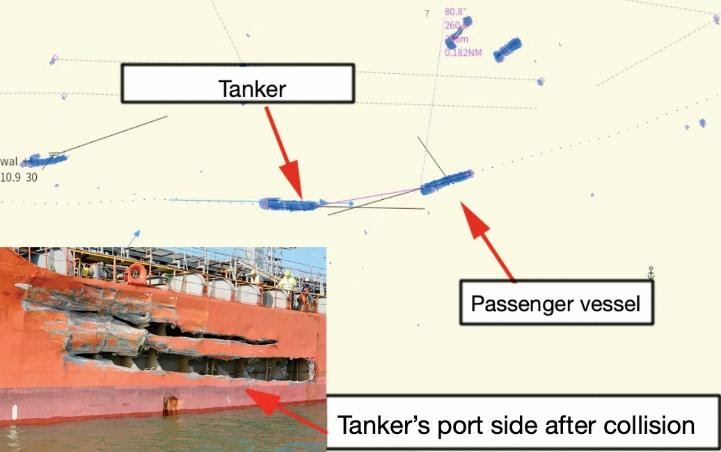A collision between a tanker and passenger vessel highlights the importance of crews of vessels contacting each other directly to pass each other safely, according to The Nautical Institute. The organisation discussed the incident in its latest Mars Reports.
The Nautical Institute gathers reports of maritime accidents and near-misses. It then publishes these so-called Mars Reports (anonymously) to prevent other accidents from happening. A summary of this incident:
A chemical tanker was up-bound in a river waterway in darkness and under pilotage. As the tanker made way upriver, the pilot contacted Vessel Traffic Services (VTS) to propose meeting arrangements with a downbound passenger vessel, suggesting to VTS that the tanker deviate to port, so that the passenger vessel would maintain its course and pass in front of the tanker, green-to-green.
The traffic controller rejected this proposal and requested a standard red-to-red meeting, requiring the tanker to maintain its course and the passenger vessel to alter to starboard. Sometime later, as the tanker and passenger vessel approached each other, the pilot on board the tanker called the passenger vessel via the traffic channel and requested confirmation of the red-to-red passage.
Also read: Assumptions and poor communication lead to vessel collision
The bridge team on the passenger vessel failed to respond to the pilot’s call, maintaining their course instead of keeping to the starboard side of the channel. VTS then called the passenger ship. This time, the crew replied. The VTS controller explained that the plan was a red-to-red passage for the ship heading in the opposite direction, referring to the tanker.
The captain of the passenger vessel replied that he had not understood, and asked for the message to be repeated. VTS repeated the red-to-red passage, at which point the master of the passenger vessel replied affirmatively. However, the vessel failed to change course to starboard.

Meanwhile, the tanker had also maintained its course and speed, and the two vessels were now rapidly approaching each other. About thirty seconds before the collision (time of diagram), the pilot on the tanker issued a warning via the VHF and shortly afterwards ordered the helmsman to turn hard to starboard so that the tanker would not hit the river cruise ship amidships, which might cause catastrophic damage. In the meantime, VTS called the passenger vessel twice to turn to starboard, but without effect. Shortly afterwards, the passenger ship and tanker collided.
Investigation findings
The investigation revealed that the crew of the passenger vessel had seen the tanker, but that based on their understanding of the communication, they believed that vessel would make a turn to port (‘red side turn’) resulting in a green to green passage. They had not understood that this plan had been refused earlier by VTS.
The investigation also found that the English communication skills of the passenger vessel’s bridge team were quite rudimentary. This may have contributed to their miscomprehension of the situation.
Also read: Language problems in inland navigation result in more collisions
Advice from The Nautical Institute
- Good communication is critical for safety.
- Meeting arrangements should ideally be made in good time and directly between the two vessels concerned, not through a third party.
- When in doubt, slow down.
Mars Reports
This accident was covered in the Mars Reports, originally published as Mars 202121, that are part of Report Number 342. A selection of this Report has also been published in SWZ|Maritime’s May 2021 issue. The Nautical Institute compiles these reports to help prevent maritime accidents. That is why they are also published on SWZ|Maritime’s website.
More reports are needed to keep the scheme interesting and informative. All reports are read only by the Mars coordinator and are treated in the strictest confidence. To submit a report, please use the Mars report form.








